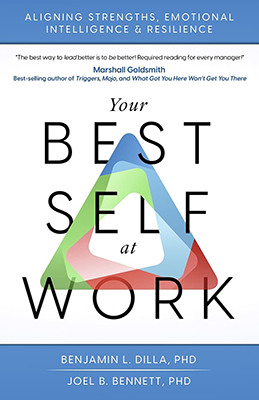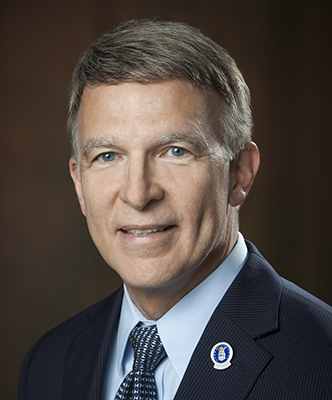 Menu
Menu


By Christopher Jay
We sat down with Affiliate Assistant Professor of Management Ben Dilla, Ph.D., to discuss his new co-authored book, Your Best Self at Work: Aligning Strengths, Emotional Intelligence & Resilience.
What spurred you and your co-author, Joel Bennett, to publish Your Best Self at Work?
I got interested in the topic because I do a lot of coaching around core talents, Gallup’s StrengthsFinder and other assessments. In our leadership classes at UD, we spend a lot of time talking about emotional intelligence and its interaction with strengths. My understanding of emotional intelligence is based on the work of Daniel Goleman, which entails how we deal with our own emotions as well as respond to the emotions of others. I noticed a gap in the literature when it came to the connection between strengths and emotional intelligence, and people weren't really talking about how they interface with each other. That was the original genesis of wanting to write the book.
I didn’t start out with a co-author. As I was developing this idea, I gave a short talk on strengths and emotional intelligence at a DFW organizational development network event in 2019. Joel Bennett gave one there on resilience and well-being, and we started talking afterward. We realized our ideas converged in interesting ways, so I asked him to write a chapter at first, but he had other ideas for the book and I ended up bringing him on as a second author. He had some great ideas for the book, such as adding chapter reflection questions, short assessments and the research notes in the back.
Can you explain the format of the book? Why did you find an “allegorical” approach to be an effective way to format it?
The book follows a fictional woman named Sam, a new manager who wants to become a more effective leader. Sam is a composite of real students I’ve had in my graduate courses in UD’s Gupta College of Business. A number of authors have followed this allegorical approach for their books, such as Ken Blanchard. I didn’t start the book doing this, but I was having writer’s block and decided to try writing it in a format similar to the work I do — to make it more of a coaching conversation. This helped me put words on paper, and it eventually evolved into an allegorical format.
Can you explain some of the ways someone can become their “best self” that you unpack in the book?
I think to be our best self, we have to be attuned to the core talents and strengths that make us uniquely us. I worked as a coach and facilitator to help people see their strengths for a long time, but this alone doesn’t take us all the way. We often encounter emotional turmoil and uncertainty, which throws us off center from using our talents and strengths. This is where emotional intelligence or stability can be important but, again, there is a gap in the strengths literature that doesn’t address the emotional component. We need to learn to apply our strengths in a judicious fashion, and emotional awareness helps us do this. During a given challenge or opportunity, we might need to dial up a strength or dial it down because it’s not a good fit for the situation. Fostering emotional intelligence gives us the ability to read the situation, understand the needs of the people around us and align our strengths in a more effective fashion.
How did you take into account some of the challenges of today when it comes to being our best self as a leader or manager?
Any change in how work is done is stressful. With COVID, for example, there was a lot of stress and uncertainty, and this is where the insights in the book can be especially helpful. Before we went to publication, Joel and I were talking about how we should include something that takes into account these difficulties, and decided to add a section called “Fifty Tips for Uncertain Times.” The section offers a review of key concepts from the book and helps readers think about them in the context of change and uncertainty. We wanted to make sure we were aware of the needs of people who are going through difficult times.
Examples of these “tips for uncertain times” include:
Keep learning. Seek opportunities to gain new skills and knowledge for personal and professional growth. These learning opportunities — training classes, job aids, resources — often happen within companies but can also be accessed at little or no cost through your local community college, workforce development agencies and online resources.
Acknowledge your own best practices. Write down several examples of past success when you did something you enjoyed doing, did it well, and had a feeling of satisfaction and fulfillment from doing it. Look for the common themes of skills, behaviors and motivations that describe you at your best. Be prepared to share those examples in job applications and interviews so others can truly see you at your best.
How can the lessons in this book help others beyond the professional or leadership spheres?
We deal with similar challenges in our social lives and families as we do in the workplace, so there is certainly a carry-over benefit. The insights from the book can help us be more effective with family and friends and acquaintances in our neighborhood or volunteer organizations, or anywhere where there is interaction with people. Developing our strengths, emotional intelligence and resilience can help us be more compassionate and better connect with a community.
I also think the book is applicable to those not in management roles. My belief about leadership is broad, and it’s that we each have opportunities to lead and influence others toward the accomplishment of a goal. It might be as a team member, or it might be with a customer, client or some other stakeholder. But we all have opportunities to lead others and so, from this standpoint, the ideas we discuss in the book are applicable to everyone.
Your Best Self at Work: Aligning Strengths, Emotional Intelligence & Resilience is available for purchase on Amazon.